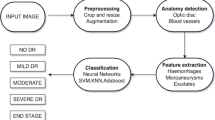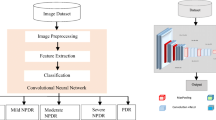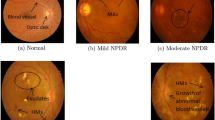Abstract
Diabetic retinopathy (DR) can be categorized on the basis of prolonged complication in the retinal blood vessels which may lead to severe blindness. Early stage prediction and diagnosis of DR requires regular eye examination to reduce the complications causing vision loss. Indicative significance of DR forecast and evaluation to help the ophthalmologists in standard screening has prompted the improvement of computerized DR recognition frameworks. This work focuses on automatic DR disease identification and its grading by the means of transfer learning approach using dynamic investigation. Our proposed approach utilizes deep neural network for feature extraction from fundus images and these features are further ensembled with supervised machine learning technique for DR grading. An optimized classification is achieved by applying an ensemble of convolution neural networks (CNNs) with statistical feature selection module and SVM classifier. The learning of classifier is achieved by the feature information transferred from CNN model to the SVM classifier, which results in remarkable performance of the learned models. Statistically optimized feature set utilized for transfer learning technique yields in the classification accuracy of 90.51% with proposed Prominent Feature-based Transfer Learning (PFTL) method employing Inception V3 model. The cost analysis of the proposed model provides a minimum cross-entropy loss of 0.295 consuming the time of 38 min 53 s, thus, maintaining a trade-off. The generalization ability of the proposed model is established by the performance assessment using latest IDRiD dataset that yields accuracy of 90.01% for Inception V3 network providing uniform outcomes for all the evaluation parameters. The diagnosis ability of the proposed transfer learning-based model is justified by comparing the proposed methods with the state-of-the-art methods. The optimized PFTL model (CNN + Statistical Analysis + SVM) outperforms other classification algorithms and provides the maximum accuracy improvement of 16.01% over the state-of-the-art techniques.








Similar content being viewed by others
References
Fong DS, Aiello L, Gardner TW, King GL, Blankenship G, Cavallerano JD, Ferris FL, Klein R (2004) Retinopathy in diabetes. Diabetes Care. 27(1):s84-7
Bhardwaj C, Jain S, Sood M (2019) Computer aided hierarchal lesion classification for diabetic retinopathy abnormalities. Int J Recent Technol Eng 8(1):2880–2887
Yen GG, Leong WF (2008) A sorting system for hierarchical grading of diabetic fundus images: a preliminary study. IEEE Trans Inf Technol Biomed 12(1):118–130
Kumar D, Taylor GW, Wong A (2019) Discovery radiomics with CLEAR-DR: Interpretable computer aided diagnosis of diabetic retinopathy. IEEE Access 7:25891–25896
ElTanboly A, Ismail M, Shalaby A, Switala A, El-Baz A, Schaal S et al (2017) A computer-aided diagnostic system for detecting diabetic retinopathy in optical coherence tomography images. Med Phys 44(3):914–923
Tariq A, Akram MU, Shaukat A, Khan SA (2013) Automated detection and grading of diabetic maculopathy in digital retinal images. J Digit Imaging 26(4):803–812
Poddar S, Jha BK, Chakraborty C (2011) Quantitative clinical marker extraction from colour fundus images for non-proliferative diabetic retinopathy grading. In: 2011 international conference on image information processing. IEEE, pp 1–6.
Fleming AD, Philip S, Goatman KA, Williams GJ, Olson JA, Sharp PF (2007) Automated detection of exudates for diabetic retinopathy screening. Phys Med Biol 52(24):7385
Abràmoff MD, Reinhardt JM, Russell SR, Folk JC, Mahajan VB, Niemeijer M, Quellec G (2010) Automated early detection of diabetic retinopathy. Ophthalmology 117(6):1147–1154
Gargeya R, Leng T (2017) Automated identification of diabetic retinopathy using deep learning. Ophthalmology 124(7):962–969
Quellec G, Charrière K, Boudi Y, Cochener B, Lamard M (2017) Deep image mining for diabetic retinopathy screening. Med Image Anal 39:178–193
Gulshan V, Peng L, Coram M, Stumpe MC, Wu D, Narayanaswamy A et al (2016) Development and validation of a deep learning algorithm for detection of diabetic retinopathy in retinal fundus photographs. JAMA 316(22):2402–2410
Prasad DK, Vibha L, Venugopal KR (2015) Early detection of diabetic retinopathy from digital retinal fundus images. In: 2015 IEEE recent advances in intelligent computational systems (RAICS). IEEE, pp. 240–245
Du N, Li Y (2013) Automated identification of diabetic retinopathy stages using support vector machine. In: Proceedings of the 32nd Chinese control conference. IEEE, pp. 3882–3886
Gurudath N, Celenk M, Riley HB (2014) Machine learning identification of diabetic retinopathy from fundus images. In: 2014 IEEE signal processing in medicine and biology symposium (SPMB). IEEE, pp. 1–7
Cao W, Shan J, Czarnek N, Li L (2017) Microaneurysm detection in fundus images using small image patches and machine learning methods. In: 2017 IEEE international conference on bioinformatics and biomedicine (BIBM). IEEE, pp 325–331
Nanni L, Ghidoni S, Brahnam S (2017) Handcrafted vs. non-handcrafted features for computer vision classification. Pattern Recogn 71:158–172
Litjens G, Kooi T, Bejnordi BE, Setio AAA, Ciompi F, Ghafoorian M et al (2017) A survey on deep learning in medical image analysis. Med Image Anal 42:60–88
Alban M, Gilligan T (2016) Automated detection of diabetic retinopathy using fluorescein angiography photographs. Report of standford education
Pratt H, Coenen F, Broadbent DM, Harding SP, Zheng Y (2016) Convolutional neural networks for diabetic retinopathy. Procedia Comput Sci 90:200–205
Rahim SS, Jayne C, Palade V, Shuttleworth J (2016) Automatic detection of microaneurysms in colour fundus images for diabetic retinopathy screening. Neural Comput Appl 27(5):1149–1164
Mansour RF (2018) Deep-learning-based automatic computer-aided diagnosis system for diabetic retinopathy. Biomed Eng Lett 8(1):41–57
Mohammedhasan M, Uğuz H (2020) A new early stage diabetic retinopathy diagnosis model using deep convolutional neural networks and principal component analysis. Traitement du Signal 37(5):711–722
Bhardwaj C, Jain S, Sood M (2020) Two-tier grading system for npdr severities of diabetic retinopathy in retinal fundus images. Recent Patents Eng 14(1):195–206
Decencière E, Zhang X, Cazuguel G, Lay B, Cochener B, Trone C, Charton B (2014) Feedback on a publicly distributed image database: the Messidor database. Image Anal Stereol 33(3):231–234
Porwal P, Pachade S, Kamble R, Kokare M, Deshmukh G, Sahasrabuddhe V, Meriaudeau F (2018) Indian diabetic retinopathy image dataset (idrid): A database for diabetic retinopathy screening research. Data 3(3):25
Bhardwaj C, Jain S, Sood M (2020) Hierarchical severity grade classification of non-proliferative diabetic retinopathy. J Ambient Intell Humanized Comput 12:2649–2670
LeCun Y, Boser BE, Denker JS, Henderson D, Howard RE, Hubbard WE, Jackel LD (1990) Handwritten digit recognition with a back-propagation network. In: Advances in neural information processing systems, pp 396–404
Xu K, Feng D, Mi H (2017) Deep convolutional neural network-based early automated detection of diabetic retinopathy using fundus image. Molecules 22(12):2054
Mohammadian S, Karsaz A, Roshan YM (2017) Comparative study of fine-tuning of pre-trained convolutional neural networks for diabetic retinopathy screening. In: 2017 24th national and 2nd international Iranian conference on biomedical engineering (ICBME). IEEE, pp. 1–6
Krizhevsky A, Sutskever I, Hinton GE (2012) Imagenet classification with deep convolutional neural networks. In: Advances in neural information processing systems, pp 1097–1105
Szegedy C, Liu W, Jia Y, Sermanet P, Reed S, Anguelov D, et al (2015) Going deeper with convolutions. In: Proceedings of the IEEE conference on computer vision and pattern recognition, pp 1–9
Simonyan K, Zisserman A (2014) Very deep convolutional networks for large-scale image recognition. arXiv preprint arXiv409.1556
He K, Zhang X, Ren S, Sun J (2016) Deep residual learning for image recognition. In: Proceedings of the IEEE conference on computer vision and pattern recognition, pp. 770–778
Szegedy C, Vanhoucke V, Ioffe S, Shlens J, Wojna Z (2016) Rethinking the inception architecture for computer vision. In: Proceedings of the IEEE conference on computer vision and pattern recognition, pp. 2818–2826
Gao Z, Li J, Guo J, Chen Y, Yi Z, Zhong J (2018) Diagnosis of diabetic retinopathy using deep neural networks. IEEE Access 7:3360–3370
Bhardwaj C, Jain S, Sood M (2018) Appraisal of pre-processing techniques for automated detection of diabetic retinopathy. In: 2018 fifth international conference on parallel, distributed and grid computing (PDGC). IEEE, pp. 734–739
Bhardwaj C, Jain S, Sood M (2019) Automatic blood vessel extraction of fundus images employing fuzzy approach. Indones J Electr Eng Inf 7(4):757–771
Janney B, Meera G, Shankar GU, Divakaran S, Abraham S (2015) Detection and classification of exudates in retinal image using image processing techniques. J Chem Pharm Sci 8:541–546
Akyol K, Şen B, Bayır Ş (2016) Automatic detection of optic disc in retinal image by using keypoint detection, texture analysis, and visual dictionary techniques. Comput Math Methods Med
Saha R, Chowdhury AR, Banerjee S, Chatterjee T (2018) Detection of retinal abnormalities using machine learning methodologies. Neural Netw World 28(5):457–471
Roychowdhury S, Koozekanani DD, Parhi KK (2013) DREAM: diabetic retinopathy analysis using machine learning. IEEE J Biomed Health Inform 18(5):1717–1728
Sharma S, Jain S, Bhusri S (2017) Two class classification of breast lesions using statistical and transform domain features. J Global Pharma Technol 26(33):18–24
Tang Y (2013) Deep learning using linear support vector machines. arXiv preprint arXiv1306.0239
Qomariah DUN, Tjandrasa H, Fatichah C (2019) Classification of diabetic retinopathy and normal retinal images using CNN and SVM. In: 2019 12th international conference on information & communication technology and system (ICTS). IEEE, pp 152–157
Basly H, Ouarda W, Sayadi FE, Ouni B, Alimi AM (2020) CNN-SVM learning approach based human activity recognition. In: International conference on image and signal processing. Springer, Cham, pp 271–281
Durakovic B (2017) Design of experiments application, concepts, examples: State of the art. Period Eng Nat Sci 5(3):421–439
Sood M (2017) Performance analysis of classifiers for seizure diagnosis for single channel EEG data. Biomed Pharmacol J 10(2):795–803
Lam C, Yi D, Guo M, Lindsey T (2018) Automated detection of diabetic retinopathy using deep learning. AMIA Summits Transl Sci Proc 2018:147
Hazim JM, Hassan HA, Yassin AIM, Tahir NM, Zabidi A, Rizman ZI, Baharom R, Wah NA (2018) Early detection of diabetic retinopathy by using deep learning neural network. Int J Eng Technol 7(441):1997–2004
Antal B, Hajdu A (2012) An ensemble-based system for microaneurysm detection and diabetic retinopathy grading. IEEE Trans Biomed Eng 59(6):1720–1726
Perdomo O, Otalora S, Rodríguez F, Arevalo J, González FA (2016) A novel machine learning model based on exudate localization to detect diabetic macular edema. In: Proceedings of the ophthalmic medical image analysis international workshop, pp 137–144
Vo HH, Verma A (2016) New deep neural nets for fine-grained diabetic retinopathy recognition on hybrid color space. In: 2016 IEEE international symposium on multimedia (ISM). IEEE, pp 209–215
Sarki R, Michalska S, Ahmed K, Wang H, Zhang Y (2019) Convolutional neural networks for mild diabetic retinopathy detection: an experimental study. bioRxiv: 763136
Funding
The authors declare that no funding is provided for this research work from any of the resources.
Author information
Authors and Affiliations
Corresponding author
Ethics declarations
Conflict of interest
The authors declare that there is no financial and personal conflict of Interest statement with any person or organizations that could inappropriately influence (bias) our work. This article does not contain any human or animals participation performed by any of the authors.
Additional information
Publisher's Note
Springer Nature remains neutral with regard to jurisdictional claims in published maps and institutional affiliations.
Rights and permissions
About this article
Cite this article
Bhardwaj, C., Jain, S. & Sood, M. Transfer learning based robust automatic detection system for diabetic retinopathy grading. Neural Comput & Applic 33, 13999–14019 (2021). https://doi.org/10.1007/s00521-021-06042-2
Received:
Accepted:
Published:
Issue Date:
DOI: https://doi.org/10.1007/s00521-021-06042-2




